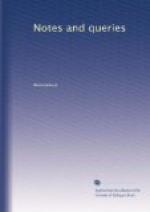CORKSCREW.
* * * * *
GOLD IN CALIFORNIA.
(Vol. ii., p. 132.)
E.N.W. refers to Shelvocke’s voyage of 1719, in which reference is made to the abundance of gold in the soil of California. In Hakluyt’s Voyages, printed in 1599-1600, will be found much earlier notices on this subject. California was first discovered in the time of the Great Marquis, as Cortes was usually called. There are accounts of these early expeditions by Francisco Vasquez Coronada, Ferdinando Alarchon, Father Marco de Nica, and Francisco de Ulloa, who visited the country in 1539 and 1540. It is stated by Hakluyt that they were as far to the north as the 37th degree of latitude, which would be about one degree south of St. Francisco. I am inclined, however, to believe from the narrations themselves that the Spanish early discoveries did not extend much beyond the 34th degree of latitude, being little higher than the Peninsular or Lower California. In all these accounts, however, distinct mention is made of abundance of gold. In one of them it is stated that the natives used plates of gold to scrape the perspiration off their bodies!
The most curious and distinct account, however, is that given in “The famous voyage of Sir Francis Drake into the South Sea, &c. in 1577”, which will be found in the third volume of Hakluyt, page 730., et seq. I am tempted to make some extracts from this, and the more so because a very feasible claim might be based upon the transaction in favour of our Sovereign Lady the Queen. At page 737. I find:
“The 5th day of June (1579) being in 43 degrees wards the pole Arctike, we found the ayre so colde, that our men being grievously pinched with the same, complained of the extremitie thereof, and the further we went, the more the colde increased upon us. Whereupon we thought it best for that time to seeke the land, and did so, finding it not mountainous, but low plaine land, till we came within thirty degrees toward the line. In which height it pleased God to send us into a faire and good baye, with a good winde to enter the same. In this baye wee anchored.”
A glance at the map will show that “in this baye” is now situated the famous city of San Francisco.




